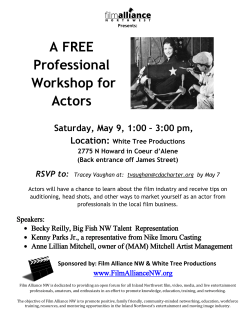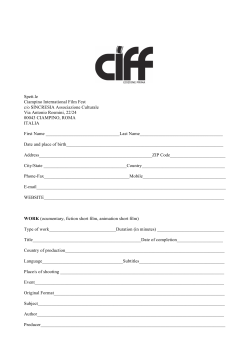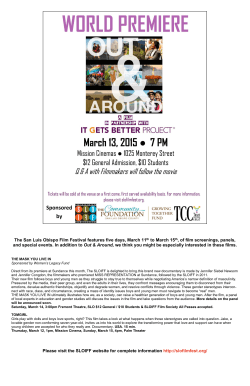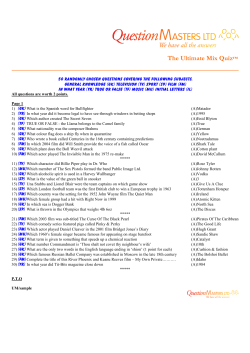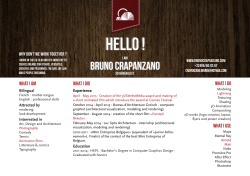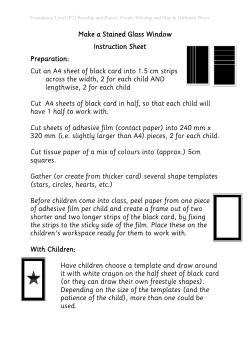
AUDIO DESCRIPTION, FILM LANGUAGE, FILM EXPERIENCE
5th Advanced Research Seminar on Audio Description Barcelona, 19th-20th March 2015 arsad Audio Description and Film Experience: Design of a Reception Study advanced research seminar on audio description Floriane Bardini, Universitat de Vic, Catalonia (Spain) – floriane.bardini@uvic.cat A UDIO DESCRIPTION , FILM LANGUAGE , FILM EXPERIENCE Film experience is a phenomenological encounter between film and viewer which happens through different modes and channels (verbal and non-verbal, audio and visual) at a sensory, sensual, cognitive and emotional level. Film language is constructed through cinematic techniques and is expressed in how images are shown and combined between themselves and with the soundtrack. The connotative meaning conveyed by film language is at least as crucial for film experience as images themselves. We are conducting a reception study on the film experience of persons with visual impairment (VIPs) in Catalonia, testing three AD styles: a conventional AD version and two AD versions where film language is included in the description. The AD styles to be tested can be positioned respectively towards the beginning, the middle and the end of Kruger’s description-narration continuum (Kruger 2010)1. M ETHODOLOGICAL APPROACH TO AD DESIGN FOR THE RECEPTION STUDY To test our three AD styles, we set up a framework to ensure that our variable – the inclusion of the meaning conveyed by film language – is the only parameter modified in the three AD versions. Following the new ADLAB audio description guidelines (Remael et al. 2014)2 we use a functional approach to characterize the three AD styles to be tested, which implies: • Functional approach to strategic decisions at a macro and micro level (represented in Fig. 1). • Target text oriented analysis of the source text (bottom-up matrix of AD related issues5, Fig. 3). • Cinematic analysis of the source text (phasal analysis5, Fig. 4). We put this methodology into practice in our reception study using Nuit Blanche, by Arev Manoukian (Spy Films 2009), a short film that takes the spectator into a surrealistic fleeting moment between a man and a woman and where visual effects play a great connotative and aesthetic role (Fig. 2). [TCR 00:03:27] [TCR 00:03:20] [TCR 00:03:32] TCR “Return to reality” 00:03:26 – 00:03:37 Follow current guidelines: UNE 153020 norm (AENOR 2005)3 and AD professional practice. Stray away from guidelines to include the aesthetics and meaning of film language in the AD, as advised by latest research (e.g. Perego 2014)4. Operative AD brief Explicitely descriptive AD(a) Descriptiveinterpretative Ad(b) Narrative Ad (c) (a) Explicitly descriptive AD: conventional AD following current guidelines by describing what is shown on screen at a denotative level. (b) Descriptive-interpretative AD: AD that offers a balance between interpretation of film language and denotative description. (c) Narrative AD: AD that concentrates on interpreting the film’s message and translating it into a coherent narration. Fig. 1 Functionalist approach to multiple AD design Music and sounds Sounds of the street Gestures and facial expressions Expressive faces Cinema techniques Dissolution Non verbal visual elements She sits at the café; her glass of wine is intact. 1d AD should allow VIPs to “perceive the message as a harmonious work which is as similar as possible to that which is perceived by the sighted.” (AENOR 2005, translation by Utray et al.) 3 Macro level strategy Spatio-temporal characteristics A restaurant (Café de Flore) The street, a corporate building Intratextual references Same place(s) as in the beginning Broken glass is sound again Fig. 3 Bottom-up analysis matrix5 (last film fragment) Fig. 2 Frames from Nuit Blanche’s denouement Fragment number and name Primary AD brief He stands in front of the corporate building. Their faces are very expressive. Non verbal audio elements Transition to fragment Editing technique: dissolve No music Sounds of the street (cars pass by) Music cut: lyrical orchestral music stops, sounds of the street resume Fig. 4 Phasal analysis5 of Nuit Blanche (last film fragment) Different AD styles for different audio described versions of Nuit Blanche’s denouement: Explicitly descriptive AD style: Descriptive-interpretative AD style: Narrative AD style (audio narration or AN): […] Their lips come closer. ... The woman sits back at the café with her glass of wine. The man stands in front of the corporate building. They look at each other and smile softly. Iconic description6 and minimal description of the facial expressions. Spectators have to realize by themselves what happened. […] Their lips are about to touch … but reality takes over. The woman sits at the café while the man stands across the street. They look at each other and smile meaningfully. Cognitive description6 and some interpretation of the facial expressions allow the audience to better grasp the meaning and feeling of the scene. […] As they are about to kiss, the magic ends and reality takes over. They have not moved from their spot, yet the way they smile at each other reveals that, for an instant, the fantasy was real. Narrative description6 with interpretation of film language and facial expressions, which narrates rather than describe the scene. E XPERIMENTAL DESIGN , TESTING AND EVALUATION Further methodological aspects of the reception study conception reside in the hybrid experimental design, with the use of both quantitative and qualitative methods to collect information. For the quantitative data gathering, we opted for a semi-experimental design. VIP participants shall complete an online questionaire after hearing one AD version. Their answers will be contrasted with the data gathered through a survey among sighted viewers who had watched Nuit Blanche without AD (results presented at the 10th Languages and the Media Conference, Berlin, November 5-7 2014). In order to gather qualitative data on the film experience of VIPs with the tested AD styles, and gain insights into their preferences, volunteers will be invited to participate in focus group interviews. Works cited: Jan Louis. 2010. “Audio narration: re-narrativising film”. Perspectives: Studies in Translatology 18 (3): 231–249. 2 Remael, Aline; Gert Vercauteren and Nina Reviers (eds.). 2014. Pictures painted in words. The ADLAB audio description guidelines. Available online at goo.gl/JbOf4H (last consulted 15/02/26). 3 AENOR. 2005. Norma UNE 153020. “Audiodescripción para personas con discapacidad visual. Requisitos para la audiodescripción y elaboración de audioguías”. Madrid: AENOR. 4 Perego, Elisa. 2014. “Chapter 5: Film language and tools”. In Anna Maszerowska; Anna Matamala and Pilar Orero (eds.). Audio Description: New Perspectives Illustrated. Amsterdam: John Benjamins. 5 Taylor, Chris. 2014. “The ADLAB Project: New Perspectives on Audio Description”. Paper presented at the 10th Languages and the Media Conference, Berlin, Germany, November 5-7. 6 Bardini, Floriane. 2013. “Audio Description of Cinematographic Language: A Comparative Study of Several Describers’ Approaches”. Paper presented at the 4th ARSAD, Barcelona, Spain, March 13–14. 1 Kruger,
© Copyright 2025

